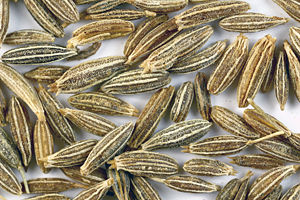Cumin/ja: Difference between revisions
Created page with "{{Nutritional value/ja | name = クミンシード | image = | caption = | serving_size = 100 g | kJ = 1567 | carbs = 44.24 g | starch = | sugars = 2.25 g | fibre = 10.5 g | fat = 22.27 g | satfat = 1.535 g | transfat = | monofat = 14.04 g | polyfat = 3.279 g | omega3fat = | omega6fat = | protein = 17.81 g | water = 8.06 g | vitA_ug = 64 | vitA_iu = 1270 | betacarotene_ug = 762 | lutein_ug = | thiamin_mg = 0.628 | riboflavin_mg = 0.327 | niacin_mg = 4.579 | pantot..." Tags: Mobile edit Mobile web edit |
|||
| Line 118: | Line 118: | ||
}} | }} | ||
===育種=== | |||
== | クミンは14個の[[Chromosome/ja|染色体]]を持つ[[Diploidy/ja|二倍体]]種である(すなわち2n = 14)。異なる品種の染色体は形態的に類似しており、長さや体積に明確な変化はない。今日利用可能な品種のほとんどは選抜されたものである。収量および収量構成要素の変動性は高い。品種は閉鎖されたチャンバーでの同胞交配やバイオテクノロジーによって開発されている。クミンは他家受粉植物であり、すなわち、すでに雑種である。したがって、育種に用いられる方法は、''[[:en:In vitro|in vitro]]''再生、DNA技術、遺伝子導入である。クミンの''in vitro''培養は、遺伝的に同一な植物の生産を可能にする。''in vitro''再生に用いられる外植片の主な供給源は、胚、[[Hypocotyl/ja|胚軸]]、茎の節間、葉、[[Cotyledon/ja|子葉]]である。クミンの育種の目標の1つは、生物的ストレス(真菌病)と非生物的ストレス(寒冷、乾燥、塩分)に対する耐性を向上させることである。クミンの在来育種の潜在的な遺伝的変異は限られており、クミンの遺伝学に関する研究は乏しい。 | ||
<div lang="en" dir="ltr" class="mw-content-ltr"> | <div lang="en" dir="ltr" class="mw-content-ltr"> | ||
Revision as of 15:42, 6 June 2025
| クミン | |
|---|---|

| |
| Scientific classification | |
| Kingdom: | Plantae |
| Clade: | Tracheophytes |
| Clade: | Angiosperms |
| Clade: | Eudicots |
| Clade: | Asterids |
| Order: | Apiales |
| Family: | Apiaceae |
| Genus: | Cuminum |
| Species: | cyminum
|
| Binomial name | |
| cyminum | |
クミン(/ˈkʌmɪn/ (![]() listen), /ˈkjuːmɪn/ (
listen), /ˈkjuːmɪn/ (![]() listen); US also /ˈkuːmɪn/ (
listen); US also /ˈkuːmɪn/ (![]() listen); Cuminum cyminum) は、セリ科の顕花植物で、イラン-トゥラン地方原産である。その種子(それぞれが果実の中に含まれており、乾燥させて使用される)は、丸ごとまたは粉砕した形で多くの文化の料理に使われている。クミンは伝統医学で使われているが、治療薬として安全または効果的であるという質の高い証拠はない。
listen); Cuminum cyminum) は、セリ科の顕花植物で、イラン-トゥラン地方原産である。その種子(それぞれが果実の中に含まれており、乾燥させて使用される)は、丸ごとまたは粉砕した形で多くの文化の料理に使われている。クミンは伝統医学で使われているが、治療薬として安全または効果的であるという質の高い証拠はない。
語源と発音
クミンという言葉は、中英語のcomyn、古英語のcymen(古高ドイツ語のkuminと同族)と古フランス語のcumminを経由しており、これらはいずれもラテン語のcuminumに由来する。さらにこれは古代ギリシア語のκύμινον (kúminon) に遡り、セム語からの借用語で、ヘブライ語のכמון (kammōn) やアラビア語のكمون (kammūn) と関連している。これらすべては最終的にアッカド語の𒂵𒈬𒉡 (kamūnu) に由来する。
英語での伝統的な発音は/ˈkʌmɪn/ (KUM-in) であり、「coming」の「-ng」(/ŋ/) の代わりに「n」を使ったような音である。アメリカの辞書編集者グラント・バレットは、この発音は現在ではほとんど使われず、20世紀後半に過剰外国語化された/ˈkjuːmɪn/ (KYOO-min) と/ˈkuːmɪn/ (KOO-min) に置き換わったと指摘している。
特徴

クミンは、セリ科の植物であるCuminum cyminumの乾燥種子である。クミンは高さ30〜50cmに成長し、手作業で収穫される。一年生草本植物で、細く無毛で分岐した茎は高さ20〜30cm、直径3〜5cmである。各枝には2〜3本の小枝がある。すべての枝は同じ高さに達するため、植物は均一な樹冠を持つ。茎は灰色または濃い緑色である。葉は長さ5〜10cmで、羽状または二回羽状に分かれ、糸状の小葉を持つ。花は小さく、白またはピンク色で、散形花序に咲く。各散形花序には5〜7個の小散形花序がある。果実は側性で紡錘形または卵形の痩果で、長さ4〜5mm、単一の種子を含む2つの分果からなる。クミンシードには油管を持つ8つの隆起がある。キャラウェイシードに似ており、長方形で縦に隆起があり、キャラウェイ、パセリ、ディルなどセリ科(Umbelliferae)の他の植物と同様に黄褐色である。
他のスパイスとの混同


クミンは、同じセリ科(Apiaceae)の別のスパイスであるキャラウェイ(Carum carvi)と混同されることがある。多くのヨーロッパやアジアの言語では、この2つを明確に区別していない。例えば、インドネシアではどちらもjintenと呼ばれる。多くのスラヴ語派やウラル語族では、クミンを「ローマのキャラウェイ」または「スパイスキャラウェイ」と呼ぶ。遠縁のBunium persicumとBunium bulbocastanum、および無関係のNigella sativaは、どちらもブラッククミンと呼ばれることがある(q.v.を参照)。
歴史


クミンは、中央アジア、南西アジア、または東地中海が原産と考えられており、何千年もの間スパイスとして使われてきた。野生のクミンの種子は、現在水没しているアトリット・ヤムの集落で発掘され、紀元前6千年紀初期のものとされている。シリアで発掘された種子は紀元前2千年紀のものとされている。また、古代エジプト新王国時代の複数の考古学的遺跡からも報告されている。古代エジプト文明では、クミンはスパイスとして、またミイラ化の際の防腐剤として使われた。
クミンは古代クレタ島のミノア文明にとって重要なスパイスであった。クミンの表意文字は、ミノア宮殿の貯蔵品を記録した線文字Aの粘土板に、ミノア後期に現れる。古代ギリシア人は食卓にクミンを専用の容器に入れていた(今日、コショウがよく置かれているのと同様に)。この習慣はモロッコでも続いている。クミンは古代ローマ料理でも多用された。インドでは、何千年もの間、数え切れないほどのレシピで伝統的な材料として使われており、他の多くのスパイスブレンドの基礎となっている。
クミンはスペインとポルトガルの入植者によってアメリカ大陸に伝えられた。ブラッククミンとグリーンクミンはペルシャ料理で使われる。今日、この植物は主にインド亜大陸、北アフリカ、メキシコ、チリ、中国で栽培されている。
栽培と生産



栽培地域
インドは世界最大のクミン生産国であり、その約70%を占めている。その他の主要なクミン生産国は、シリア(13%)、トルコ(5%)、アラブ首長国連邦(3%)、イランである。インドは2020年から2021年の会計年度に856,000トンのクミン種子を生産した。
気候条件
クミンは乾燥に強い熱帯または亜熱帯作物である。霜に弱く、120日の無霜期間を成長期とする。最適な生育温度範囲は25〜30℃である。地中海性気候がその生育に最も適している。クミンの栽培には、3〜4ヶ月の長く暑い夏が必要である。低温になると、葉の色が緑から紫色に変化する。高温は生育期間を短縮し、早期成熟を誘発する可能性がある。インドでは、クミンは10月から12月上旬まで播種され、2月に収穫が始まる。シリアとイランでは、クミンは11月中旬から12月中旬まで播種され(1月中旬まで延長可能)、6月/7月に収穫される。
等級付け
市場に出回っているクミンシードの注目すべき3つの種類は、種子の色合い、油の量、風味によって異なる。
- イラン産
- インド産、南アジア産
- 中東産
栽培条件
クミンは種子から栽培される。種子の発芽には2〜5℃が必要であり、20〜30℃が最適とされている。クミンは特に開花期と初期の種子形成期に霜害を受けやすい。霜害を軽減する方法としては、硫酸(0.1%)を散布すること、霜が降りる前に作物に水をやること、防風林を設置すること、または早朝に煙幕を張ることなどがある。クミンの苗はかなり小さく、生育力も低い。播種前に種子を8時間浸漬すると発芽が促進される。最適な植物個体数を確保するためには、12〜15kg/haの播種密度が推奨される。通気性が良く、適切な排水性があり、酸素供給量が多い肥沃な砂質ローム土壌が好ましい。土壌のpH最適範囲は6.8から8.3であり、重粘土からの発芽はかなり困難である。したがって、クミンの最適な定着には、適切な苗床準備(平らな床)が不可欠である。
クミンには、散播と条播の2つの播種方法が用いられる。散播の場合、畑を畝に区切り、種子を畝全体に均一に散播する。その後、熊手を使って土で覆う。条播の場合、20〜25cm間隔でフックを使って浅い溝を作る。次に、これらの溝に種子を置き、土で覆う。条播は、除草、中耕、散布などの栽培管理作業に利点がある。推奨される播種深さは1〜2cm、推奨される播種密度は1平方メートルあたり約120株である。クミンの水分要求量は他の多くの種よりも少ない。それにもかかわらず、クミンは苗の生育に十分な水分を確保するために、播種後にしばしば灌漑される。灌漑の量と頻度は気候条件によって異なる。
栽培管理
クミンの原産地における相対湿度はかなり低い。高い相対湿度(すなわち湿潤な年)は真菌病を助長する。クミンは特にアルテルナリア病害とフザリウム萎凋病に感受性が高い。早期に播種された作物は、遅く播種された作物よりも強い病害影響を示す。最も重要な病害はFusarium萎凋病であり、最大80%の収量損失をもたらす。Fusariumは種子または土壌伝染性であり、疫病の発生には特定の土壌温度が必要である。不適切な施肥はFusarium疫病を助長する可能性がある。クミン葉枯病(Alternaria)は、葉や茎に黒褐色の斑点として現れる。開花後に天候が曇りがちになると、病害の発生が増加する。もう一つの、しかし重要度の低い病害はうどんこ病である。初期生育におけるうどんこ病の発生は、種子が形成されないため劇的な収量損失を引き起こす可能性がある。生育後期には、うどんこ病は変色した小さな種子を引き起こす。
病原菌は作物の収量を大幅に減少させる可能性がある。クミンは開花期にアブラムシ(モモアカアブラムシ)に襲われることがある。アブラムシは柔らかい部分や花から植物の汁を吸う。植物は黄化し、種子形成が減少し(収量減少)、収穫物の品質が低下する。ひどく infested した植物の部分は除去すべきである。その他の重要な害虫は、しばしば作物を襲うダニ(Petrobia latens)である。ダニは主に若い葉を食べるため、若い花序で被害がより深刻になる。
クミンの開かれた樹冠もまた問題である。入射光のごく一部しか吸収されない。クミンの葉面積指数は低い(約1.5)。これは、雑草が水や光などの必須資源を求めてクミンと競合し、それによって収量を低下させる可能性があるため問題となりうる。クミンの生育が遅く背が低いことも、雑草との競合をさらに助長する。雑草防除のためには、2回の中耕と除草作業(播種後30日目と60日目)が必要である。最初の除草作業(播種後30日目)では、余分な植物を除去するための間引きも行うべきである。インドでは、播種前または出芽前除草剤の使用が非常に効果的であるが、この種の除草剤散布は雑草防除を成功させるために土壌水分を必要とする。
| 100 gあたりの栄養価 | |||||||||||||||||||||||||||||||||||||||||||||||||||||||||
|---|---|---|---|---|---|---|---|---|---|---|---|---|---|---|---|---|---|---|---|---|---|---|---|---|---|---|---|---|---|---|---|---|---|---|---|---|---|---|---|---|---|---|---|---|---|---|---|---|---|---|---|---|---|---|---|---|---|
| エネルギー | 1,567 kJ (375 kcal) | ||||||||||||||||||||||||||||||||||||||||||||||||||||||||
44.24 g | |||||||||||||||||||||||||||||||||||||||||||||||||||||||||
| 砂糖 | 2.25 g | ||||||||||||||||||||||||||||||||||||||||||||||||||||||||
| 食物繊維 | 10.5 g | ||||||||||||||||||||||||||||||||||||||||||||||||||||||||
22.27 g | |||||||||||||||||||||||||||||||||||||||||||||||||||||||||
| 飽和 | 1.535 g | ||||||||||||||||||||||||||||||||||||||||||||||||||||||||
| 一価不飽和 | 14.04 g | ||||||||||||||||||||||||||||||||||||||||||||||||||||||||
| 多価不飽和 | 3.279 g | ||||||||||||||||||||||||||||||||||||||||||||||||||||||||
17.81 g | |||||||||||||||||||||||||||||||||||||||||||||||||||||||||
| |||||||||||||||||||||||||||||||||||||||||||||||||||||||||
| その他の成分 | 量 | ||||||||||||||||||||||||||||||||||||||||||||||||||||||||
| 水 | 8.06 g | ||||||||||||||||||||||||||||||||||||||||||||||||||||||||
| †割合は、カリウムを除き、成人に対する米国 推奨値を使用して推定された。カリウムは、全米科学・工学・医学アカデミーの専門家による推奨に基づき推定された。 | |||||||||||||||||||||||||||||||||||||||||||||||||||||||||
育種
クミンは14個の染色体を持つ二倍体種である(すなわち2n = 14)。異なる品種の染色体は形態的に類似しており、長さや体積に明確な変化はない。今日利用可能な品種のほとんどは選抜されたものである。収量および収量構成要素の変動性は高い。品種は閉鎖されたチャンバーでの同胞交配やバイオテクノロジーによって開発されている。クミンは他家受粉植物であり、すなわち、すでに雑種である。したがって、育種に用いられる方法は、in vitro再生、DNA技術、遺伝子導入である。クミンのin vitro培養は、遺伝的に同一な植物の生産を可能にする。in vitro再生に用いられる外植片の主な供給源は、胚、胚軸、茎の節間、葉、子葉である。クミンの育種の目標の1つは、生物的ストレス(真菌病)と非生物的ストレス(寒冷、乾燥、塩分)に対する耐性を向上させることである。クミンの在来育種の潜在的な遺伝的変異は限られており、クミンの遺伝学に関する研究は乏しい。
Uses
Cumin seed is used as a spice for its distinctive flavor and aroma. Cumin can be found in some cheeses, such as Leyden cheese, and in some traditional breads from France. Cumin can be an ingredient in chili powder (often Tex-Mex or Mexican-style) and is found in achiote blends, adobos, sofrito, garam masala, curry powder, and bahaarat, and is used to flavor numerous commercial food products. In Indian and other South Asian cuisine, it is often combined with coriander seeds in a powdered mixture called dhana jeera.
Cumin can be used ground or as whole seeds. It imparts an earthy, warming and aromatic character to food, making it a staple in certain stews and soups, as well as spiced gravies such as curry and chili. It is also used as an ingredient in some pickles and pastries.
Traditional
In India, the seeds are powdered and used in different forms such as kashaya (decoction), arishta (fermented decoction), and vati (tablet/pills), and processed with ghee (a semifluid clarified butter). In traditional medicine practices of several countries, dried cumin seeds are assumed to have medicinal purposes, although there is no scientific evidence for any use as a drug or medicine.
Volatiles and essential oil
Cuminaldehyde, cymene, and terpenoids are the major volatile components of cumin oil, which is used for a variety of flavors, perfumes, and essential oil. Cumin oil may be used as an ingredient in some cosmetics.
Aroma
Cumin's flavor and warm aroma are due to its essential oil content, primarily the aroma compound cuminaldehyde. Other aroma compounds of toasted cumin are the substituted pyrazines, 2-ethoxy-3-isopropylpyrazine, 2-methoxy-3-sec-butylpyrazine, and 2-methoxy-3-methylpyrazine. Other components include γ-terpinene, safranal, p-cymene, and β-pinene.
栄養価
100gの摂取量あたり、クミンシードは1日の摂取量の脂肪(特に一価不飽和脂肪)、タンパク質、食物繊維を多く含む(表)。ビタミンB群、ビタミンE、およびいくつかのミネラル、特に鉄、マグネシウム、マンガンが、1日の摂取量のかなりの量含まれている。
外部リンク
 [[wikibooks:Cookbook:Cumin |]] at the Wikibooks Cookbook subproject
[[wikibooks:Cookbook:Cumin |]] at the Wikibooks Cookbook subproject The dictionary definition of cumin/ja at Wiktionary
The dictionary definition of cumin/ja at Wiktionary
| この記事は、クリエイティブ・コモンズ・表示・継承ライセンス3.0のもとで公表されたウィキペディアの項目Cumin(29 May 2025, at 19:56編集記事参照)を翻訳して二次利用しています。 |